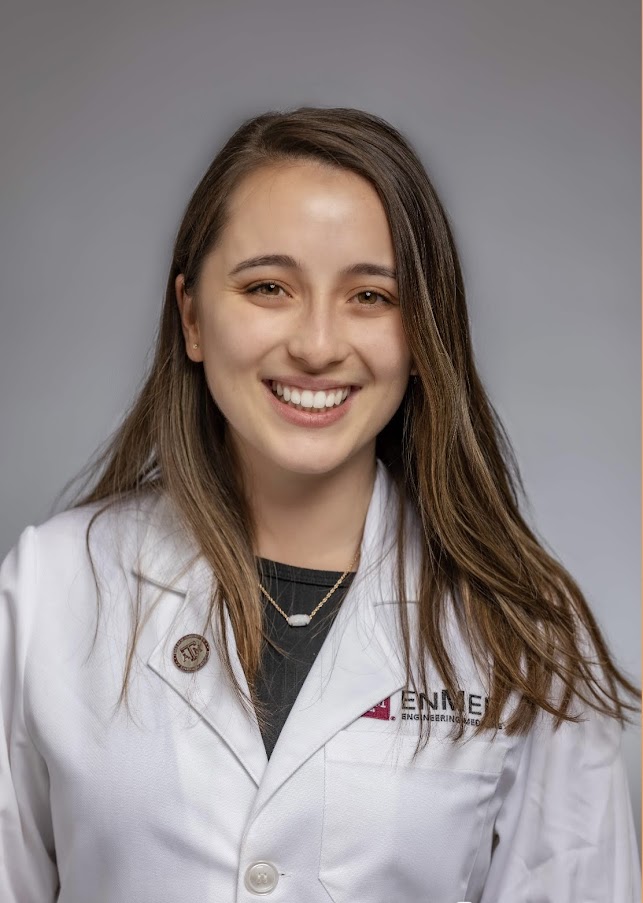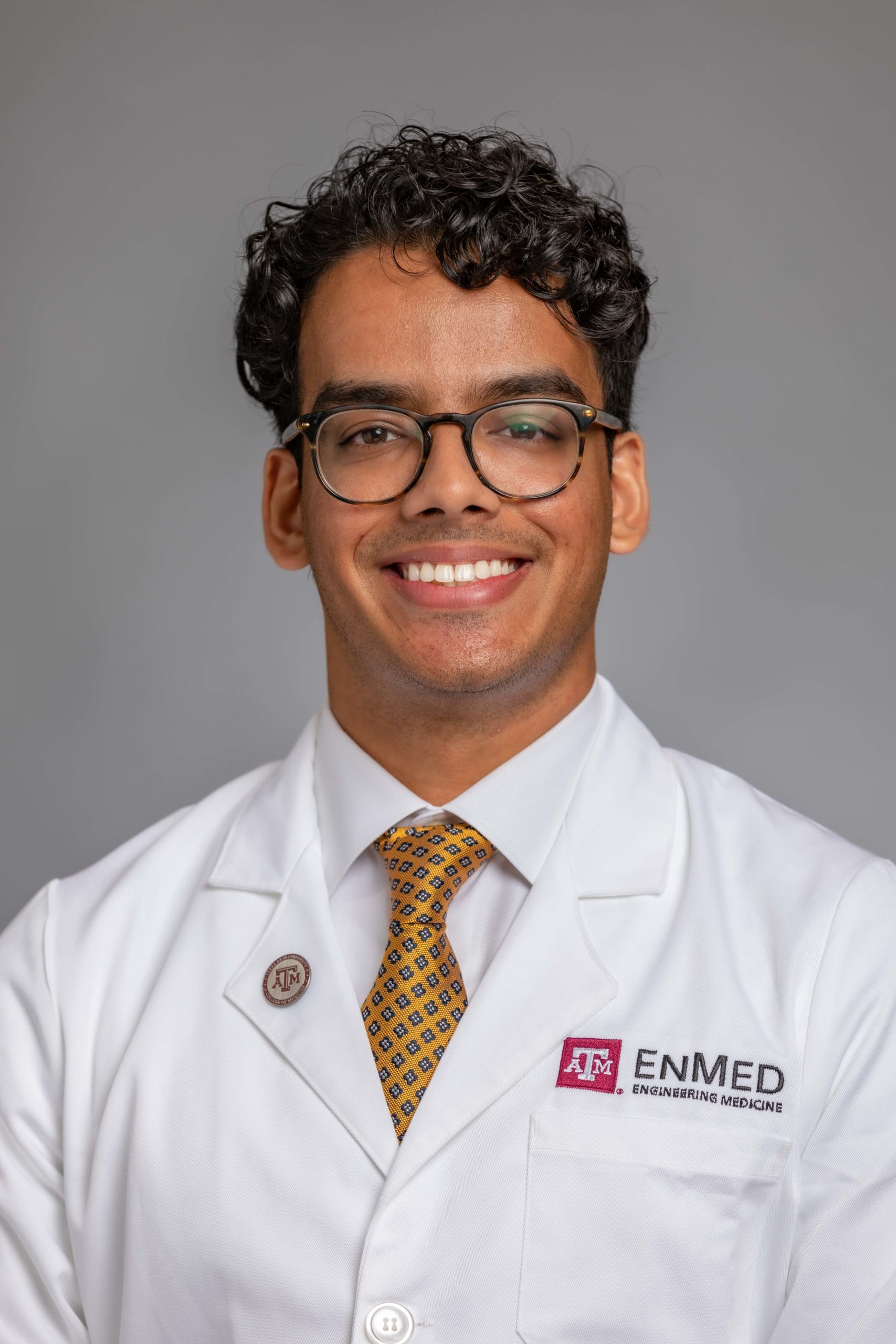Biomedical Imaging and Instrumentation
(G-257) Shoulder Sling with Integrated Compliance System for Post-Operative Monitoring
- DR
Dr. Andrew Robbins
Research Assistant Professor
1. Multidisciplinary Engineering Department, Texas A&M University 2. Mechanical Engineering Department, Texas A&M University 3. School of Engineering Medicine, Texas A&M UNiversity 4. Department of Translational Medicine, School of Medicine, Texas A&M University 5. Department of Cardiovascular Sciences, Houston Methodist Hospital, United States 
Alexandra Ramos
Medical Student
Texas A&M School of Engineering Medicine
Houston, Texas, United States
Basil P. Alias
Medical Student
Texas A&M University School of Engineering Medicine (EnMed)
Lewisville, Texas, United States- CL
Christine M. Lannon
Medical student
Texas A&M School of Engineering Medicine, Texas, United States - CC
Claire Collins
Medical Student
Texas A&M School of Engineering Medicine, United States - PM
Pujita Munnangi
Medical Student
Texas A&M School of Engineering Medicine, United States - JA
Jordan Ankersen
Graduate Research Assistant Department of Biomedical Engineering
Houston Methodist Hospital, United States - PM
Patrick McCulloch
Orthopedic Surgeon
Houston Methodist Hospital, United States
Presenting Author(s)
Co-Author(s)
Co-Author(s)
Shoulder injuries, including rotator cuff tendinopathy, account for $3 billion in healthcare costs and 4.5 million doctor visits in the United States per year and are most common in adults, particularly those involved in overhead athletics including baseball and softball. 1,2,3 In the case of a rotator cuff tear, surgical repair is often the indicated treatment after failure of conservative measures such as rest, applying ice, and physical therapy. 4,5 Post-operative care includes early immobilization in a shoulder sling to prevent re-tearing any repaired tendons, a complication tied to both increased time and cost of recovery. 6,7 Physicians and physical therapists evaluate patient compliance with wearing a shoulder sling by asking the patient directly at post-operative appointments. As shoulder sling compliance is an important component of post-operative care, there is a need to more accurately assess shoulder sling compliance. Therefore, the purpose of this study is to develop a monitoring system that utilizes multiple sensors and collection modalities that seamlessly integrate into the shoulder sling in order to continuously measure postoperative sling compliance in order to improve surgical outcomes and reduce rotator cuff tendon injuries. In this study, compliance refers to a patient following medical advice, in this case, wearing a shoulder sling.
Materials and Methods::
Interviews with stakeholders, including orthopedic surgeons and shoulder repair patients, revealed several device design requirements. These include patient comfort, safety, reliable data collection, high sampling rate, and ease of use for both patient and provider. We elected to use temperature sensors integrated into the sling focused on three different regions with high skin-sling contact due to their high reliability over long periods of time, low energy consumption and longer refractory periods that naturally reduce data collection noise. IRB approval was obtained from the Human Research Protection Program at Texas A&M University’s Division of Research, allowing for the participation of healthy subjects between the ages of 18-55 with no history of shoulder injuries or limited range of motion.
Data was collected from three temperature probes integrated in the shoulder sling over 4 hours at a sampling rate of once per minute. The acquired temperature data was compared to self-reported sling wear-time logs. The calculated wear-time was determined by the rate of temperature change in a 3 minute span, such that if the temperature rose or dropped more than 5 degrees in 3 minutes, it would indicate sling removal or application.
Results, Conclusions, and Discussions::
The total wear time predicted by the algorithm for temperature sensors 1, 2, and 3 were 161, 161, and 157 minutes, respectively; whereas the total wear time logged by the user was 157 minutes. The accuracy between the temperature sensors and self-reported data (Sensor 1: 97.6%; Sensor 2: 97.6%; Sensor 3: 98.4%) indicate that the temperature probes can accurately and accurately predict sling wear times at each location. Additionally, the average temperatures during times when the sling was worn and not worn for each of the three sensors exhibited significant differences (p < 0.01), as displayed in Plot 1.
temperature sensors are a cheap and accurate sensor that when integrated into a sling, can provide valuable data for providers and patients.
The ability to detect sling removal based on temperature probes is feasible, as demonstrated in Plot 1. This data can be collected and shared with the orthopedic surgeon overseeing a patient’s postoperative care in order to better estimate sling wear time. Patterns in wear time can be extrapolated from the reported data to predict when patients are most likely to remove their sling. This information can be used to explore patient barriers to compliance and counsel patients on the importance of maximizing their wear time immediately after surgery. Compliance data can be exported to the physician if a patient’s postoperative care is primarily virtual, which is becoming increasingly more common. Additionally, compliance data can be shared between physicians and physical therapists to communicate patterns and adjust postoperative care as needed. Once more data is collected, the algorithm can be adjusted to improve sling removal detection accuracy resulting in overall better compliance reporting.
Acknowledgements (Optional): :
References (Optional): :
